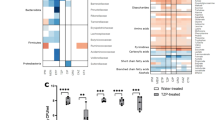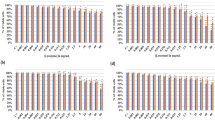Abstract
To evaluate the potential antibiotic resistance capability of cultured human colonic microbiota as a whole system when residual antibiotics enter the human intestine, the combination of viable cell counting and denaturing gradient gel electrophoresis (DGGE) method was used to study effects of the enrofloxacin (ENR) residue on the microbial diversity, antibiotic resistance, and anti-colonization capability in a human chemostat model. The results indicated that the ENR enhanced the microbial antibiotic resistance to the ciprofloxacin (CI), and a dose-dependent effect was observed. When exposed to 1.25 μg/mL ENR, the growth of the tested bacteria (e.g., total aerobic bacteria, total anaerobic bacteria, Lactobacillus, Enterococci, Escherichia coli, Bacteroides fragilis) received little change, while the microbial diversity in this group was totally changed; In 12.5- and 125-μg/mL ENR group, the quantities and microbial diversity received a dramatic change compared to their no drug stage, while the addition of the cultured human colonic microbiota to the probiotic group did enhance the colonization resistance (CR) of the cultured microbiota to Candida albicans SC5314, indicating its potential beneficial effect on human intestinal healthy and anti-infection capability.



Similar content being viewed by others
References
Balcázar, J. L., Blas, I. d., Ruiz-Zarzuela, I., Cunningham, D., Vendrell, D., & Múzquiz, J. L. (2006). The role of probiotics in aquaculture. Veterinary Microbiology, 114(3), 173–186.
Barbour, E. K., Ahmadieh, D., Harakeh, S., & Kumosani, T. (2013). Impact of antimicrobials use in chickens on emergence of drug-resistant Campylobacter organisms in humans. International Arab Journal of Antimicrobials Agents, 2(4).
Biancone, L., Monteleone, I., Del Vecchio Blanco, G., Vavassori, P., & Pallone, F. (2002). Resident bacterial flora and immune system. Digestive and Liver Disease, 34, S37–S43.
Carman, R. J., & Woodburn, M. A. (2001). Effects of low levels of ciprofloxacin on a chemostat model of the human colonic microflora. Regulatory Toxicology and Pharmacology, 33(3), 276–284.
Cerniglia, C., & Kotarski, S. (2005). Approaches in the safety evaluations of veterinary antimicrobial agents in food to determine the effects on the human intestinal microflora. Journal of Veterinary Pharmacology and Therapeutics, 28(1), 3–20.
Chen, T., Jiang, S., Xiong, S., Wang, M., Zhu, D., & Wei, H. (2012). Application of denaturing gradient gel electrophoresis to microbial diversity analysis in Chinese Douchi. Journal of the Science of Food and Agriculture, 92(10), 2171–2176.
Chen, T., Wang, M., Jiang, S., Xiong, S., Zhu, D., & Wei, H. (2011). Investigation of the microbial changes during koji‐making process of Douchi by culture‐dependent techniques and PCR‐DGGE. International Journal of Food Science and Technology, 46(9), 1878–1883.
Chen, T., Yuan, J., Feng, X., Wei, H., & Hua, W. (2011). Effects of enrofloxacin on the human intestinal microbiota in vitro. International Journal of Antimicrobial Agents, 37(6), 567–571.
Donskey, C., Hujer, A., Das, S., Pultz, N., Bonomo, R., & Rice, L. (2003). Use of denaturing gradient gel electrophoresis for analysis of the stool microbiota of hospitalized patients. Journal of Microbiological Methods, 54(2), 249–256.
Fujimura, K. E., Slusher, N. A., Cabana, M. D., & Lynch, S. V. (2010). Role of the gut microbiota in defining human health. Expert Review of Anti-Infective Therapy, 8(4), 435–454.
Gibson, G. R., Cummings, J. H., & Macfarlane, G. T. (1988). Use of a three-stage continuous culture system to study the effect of mucin on dissimilatory sulfate reduction and methanogenesis by mixed populations of human gut bacteria. Applied and Environmental Microbiology, 54(11), 2750–2755.
Goldin, B. R., & Gorbach, S. L. (1992). Probiotics for humans. In Probiotics (pp. 355-376): Springer.
Greenblum, S., Turnbaugh, P. J., & Borenstein, E. (2012). Metagenomic systems biology of the human gut microbiome reveals topological shifts associated with obesity and inflammatory bowel disease. Proceedings of the National Academy of Sciences, 109(2), 594–599.
Guarner, F., Casellas, F., Borruel, N., Antolin, M., Videla, S., Vilaseca, J., & Malagelada, J. (2002). Role of microecology in chronic inflammatory bowel diseases. European Journal of Clinical Nutrition, 56, S34.
Hempel, S., Newberry, S. J., Maher, A. R., Wang, Z., Miles, J. N., Shanman, R., Johnsen, B., & Shekelle, P. G. (2012). Probiotics for the prevention and treatment of antibiotic-associated diarrhea a systematic review and meta-analysis. JAMA, the Journal of the American Medical Association, 307(18), 1959–1969.
Kim, B.-S., Kim, J. N., Yoon, S.-H., Chun, J., & Cerniglia, C. E. (2012). Impact of enrofloxacin on the human intestinal microbiota revealed by comparative molecular analysis. Anaerobe, 18(3), 310–320.
Martin, F.-P. J., Wang, Y., Sprenger, N., Yap, I. K., Rezzi, S., Ramadan, Z., Peré-Trepat, E., Rochat, F., Cherbut, C., & van Bladeren, P. (2008). Top-down systems biology integration of conditional prebiotic modulated transgenomic interactions in a humanized microbiome mouse model. Molecular Systems Biology, 4(1).
Nicolaisen, M., & Ramsing, N. (2002). Denaturing gradient gel electrophoresis (DGGE) approaches to study the diversity of ammonia-oxidizing bacteria. Journal of Microbiological Methods, 50(2), 189–203.
Packey, C. D., & Sartor, R. B. (2009). Commensal bacteria, traditional and opportunistic pathogens, dysbiosis and bacterial killing in inflammatory bowel diseases. Current Opinion in Infectious Diseases, 22(3), 292.
Perrin-Guyomard, A., Poul, J.-M., Corpet, D. E., Sanders, P., Fernández, A. H., & Bartholomew, M. (2005). Impact of residual and therapeutic doses of ciprofloxacin in the human-flora-associated mice model. Regulatory Toxicology and Pharmacology, 42(2), 151–160.
Sartor, R. B. (2004). Microbial influences in inflammatory bowel disease: role in pathogenesis and clinical implications. Kirsner’s Inflammation Bowel Disease, 6.
Singh, D. D., Amdeka, S., & Singh, V. (2012). Probiotics: defenders of gastrointestinal habitats. Gastroenterology Insights, 4(2), e22.
Terg, R., Llano, K., Cobas, S. M., Brotto, C., Barrios, A., Levi, D., Wasen, W., & Bartellini, M. A. (1998). Effects of oral ciprofloxacin on aerobic gram-negative fecal flora in patients with cirrhosis: results of short-and long-term administration, with daily and weekly dosages. Journal of Hepatology, 29(3), 437–442.
Wang, T., Zhang, X., Zhang, M., Wang, L., & Zhao, L. (2011). Development of a fluorophore-ribosomal DNA restriction typing method for monitoring structural shifts of microbial communities. Archives of Microbiology, 193(5), 341–350.
Acknowledgments
The authors would like to thank Dr Carman & Dr Woodbridge (TechLab Inc., Blacksburg, 257 VA) and Dr Hongbo Xin (Institute of Translational Medicine, Nanchang University) for their valuable methodologies. This work was supported by grants from the The Ministry of science and technology “creation of major new drugs” special (2011ZX09102-009-01) and The landing plan project of Jiangxi Province (QT43-3).
Author information
Authors and Affiliations
Corresponding authors
Rights and permissions
About this article
Cite this article
Chen, T., Li, S. & Wei, H. Antibiotic Resistance Capability of Cultured Human Colonic Microbiota Growing in a Chemostat Model. Appl Biochem Biotechnol 173, 765–774 (2014). https://doi.org/10.1007/s12010-014-0882-6
Received:
Accepted:
Published:
Issue Date:
DOI: https://doi.org/10.1007/s12010-014-0882-6




